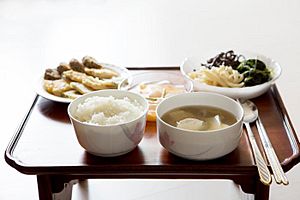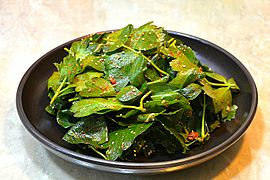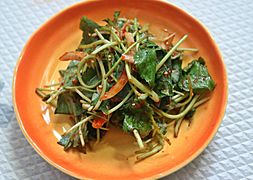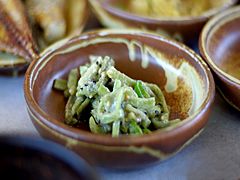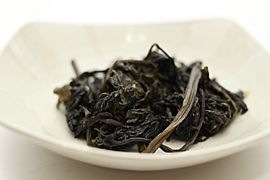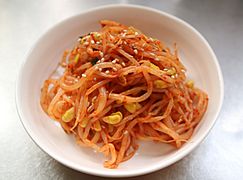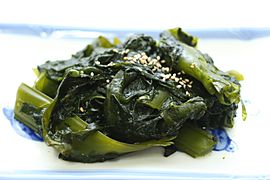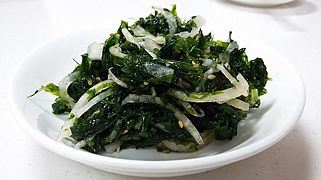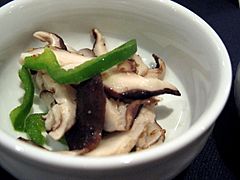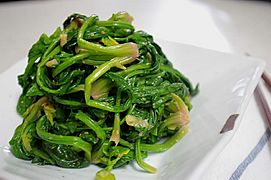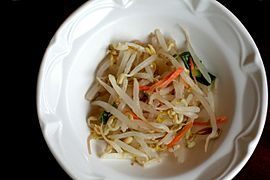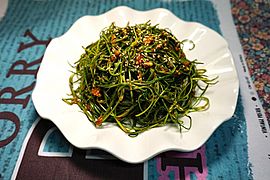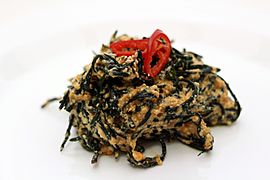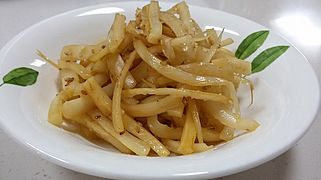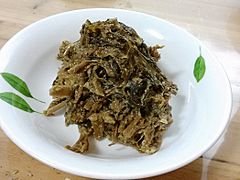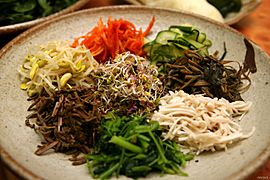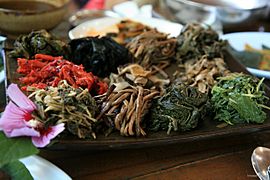Namul facts for kids
| Namul | |
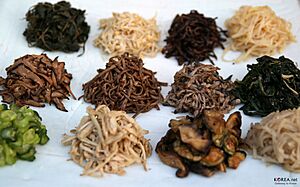 |
|
Quick facts for kids Korean name |
|
|---|---|
| Hangul |
나물
|
| Revised Romanization | namul |
| McCune–Reischauer | namul |
| IPA | [na.mul] |
Namul (Korean: 나물) is a popular type of Korean dish. It can mean two things:
- It's a general word for different kinds of edible plants, like grasses or leaves.
- It also refers to delicious side dishes made from these plants, often seasoned with various flavors.
When Koreans talk about san-namul (산나물), they mean wild greens picked from mountains. Bom-namul (봄나물) are fresh vegetables harvested in spring.
There's a special day called Daeboreum, which is the first full moon of the year. On this day, Koreans traditionally eat boreum-namul (보름나물) with five-grain rice. People believe that eating these full moon namuls in winter helps them stay strong and healthy, especially to handle the heat of the upcoming summer.
Contents
Making and Serving Namul Dishes
You can make namul dishes from almost any kind of vegetable, herb, or green plant. This includes roots, leaves, stems, seeds, sprouts, flowers, and even fruits! Sometimes, seaweeds, mushrooms, and other ingredients are also used.
Most of the time, the vegetables are first blanched. This means they are quickly dipped in boiling water and then cooled. This helps them keep their color and a nice texture. But namul can also be prepared in other ways:
- They can be served fresh and raw.
- They can be boiled, fried, or sautéed (cooked quickly in a little oil).
- Sometimes, they are fermented or steamed.
Namul dishes get their amazing taste from different seasonings. Common ingredients include:
- Salt and vinegar
- Sesame oil and perilla oil
- Different kinds of soy sauce
- Doenjang (a savory soybean paste)
- Gochujang (a spicy chili paste)
- Many other spices and flavors!
Namul is usually served as a banchan (반찬). These are small side dishes that come with the main meal, usually with rice. It's common to have several different types of namul served at one meal.
Each namul dish often gets its name from its main ingredient and how it's prepared. For example, a seasoned dish made from chamnamul is called chamnamulmuchim. This name literally means "seasoned chamnamul." If you have a namul made from raw radish, it's called musaengchae, which means "seasoned raw radish."
Common Ingredients for Namul
Many different plants and other foods are used to make namul. Here are some of the most common types:
Vegetables
- aehobak (애호박, Korean zucchini)
- banga (방아, Korean mint)
- bangpung (방풍, coastal hogfennel)
- Bean sprouts
- kongnamul (콩나물, soybean sprout)
- sukjunamul (숙주나물, mung bean sprout)
- bireum (비름, edible amaranth)
- buchu (부추, garlic chive)
- chamnamul (참나물, short-fruit pimpinella)
- chwinamul (취나물)
- dallae (달래, Korean wild chive)
- deodeok (더덕, lance asiabell root)
- doraji (도라지, balloon flower root)
- dureup (두릅, Korean angelica tree shoot)
- gaji (가지, eggplant)
- gat (갓, mustard green)
- geundae (근대, chard)
- kkaennip (깻잎, perilla leaves)
- gobi (고비, Asian royal fern)
- gogumasun (고구마순, sweet potato shoot)
- gondre (곤드레, Korean thistle)
- gosari (고사리, eastern brackenfern)
- minari (미나리, Java waterdropwort)
- mu (무, Korean radish)
- myeongi (명이, Siberian onion)
- naengi (냉이, shepherd's purse)
- oi (오이, cucumber)
- pa (파, scallion or green onion)
- sigeumchi (시금치, spinach)
- siraegi (시래기, dried radish green)
- ssukgat (쑥갓, crowndaisy chrysanthemum)
- ssuk (쑥, Korean mugwort)
- yuchae (유채, rapeseed green)
Seaweeds
Mushrooms
Other Ingredients
- gonyak (곤약, konjac jelly)
- muk (묵, a type of jelly)
- dotorimuk (도토리묵, acorn jelly)
- memilmuk (메밀묵, buckwheat jelly)
- nokdumuk (녹두묵, mung bean jelly)
- cheongpomuk (청포묵, white mung bean jelly)
- hwangpomuk (황포묵, yellow mung bean jelly)
Gallery
-
bangpung-namul
-
Gondre-namul
-
Gosari-namul
-
Miyeok-namul
-
Parae-namul
-
Pyogo-namul
-
Sigeumchi-namul
-
Tot-namul
-
Doraji-namul
-
Ssukgat-namul
-
Siraegi-namul
-
Various namuls for bibimbap
-
Sanchae table d'hôte
See also
 In Spanish: Namul para niños
In Spanish: Namul para niños


